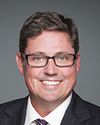Right now we're in three clubs across Canada. It's going to be positioned to go into 10 clubs this year, including one club here in Ottawa.
Essentially, at Boys and Girls Clubs, anyone is welcome. Most club members range in age from six to 18, and the focus is on giving them an opportunity. Here in Ottawa there are no fees attached at all to be a member, so if you want to become a club member, you just show up and we give you a registration form and you're good to go.
Obviously, our focus is going to be strategically on those kids who are dealing with trauma at home, and who have gone through situations that might have been very challenging, and to support them through those through physical activity.
I witnessed one program at the Okanagan Boys and Girls Club. I saw young people who, frankly, didn't take part in activities before because of trauma and being part of those activities really made an impact on them.
When we think of sport, we think it's just recreation, that it's just for fun, but it's so much more than that. It teaches life skills and competencies. It teaches people how to have resilience and perseverance. That's what the Bounce Back League is all about.





